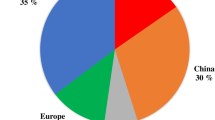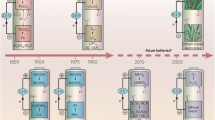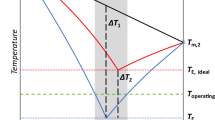Abstract
The study of the phase equilibrium characteristics of CO2-ionic liquids (ILs) as new absorption-compression type refrigeration working pairs is of great importance. Three kinds of ILs, i.e., [emim][FAP], [bmim][FAP] and [hmim][FAP], were chosen as potential absorbents. The solubility of CO2 in these ILs was measured experimentally within 0 to 5.0 MPa at temperatures of 293.15 K to 333.15 K, and the effects of temperature, pressure, IL anion and cation structure and stirring action on CO2 solubility were also discussed and analyzed. The results showed that the longer alkyl chains in an identical IL family, the alkyl fluoride group in IL anions and the stirring action by a magnetic stirrer had positive effects on the solubility of CO2. In the three ILs, [hmim][FAP] possessed the best performance for CO2 absorption; the solubility of CO2 reached 0.7641 at a pressure of 5 MPa and temperature of 293.15 K, the maximum solubility measured in this work. The CO2-[hmim][FAP] binary mixture is recommended as a potentially applicable working pair for CO2 absorption-compression refrigeration systems.
Similar content being viewed by others
Abbreviations
- M :
-
molecular weight
- m :
-
mass/kg
- n :
-
amount of substance/mol
- P :
-
pressure/MPa
- R :
-
universal gas constant/J·mol−1·K−1
- T :
-
temperature/K
- V :
-
volume/mL
- x :
-
mole fraction
- Z :
-
compression factor
- Á :
-
density/g·cm−3
- EC:
-
Equilibrium cell
- GR:
-
Gasholder
- E:
-
Equilibrium
- APSD:
-
Average percentage of solubility difference
- B:
-
Buffer tank
- IL:
-
Ionic liquid
- PSD:
-
Percentage of solubility difference
References
Wu X.M., Hu S., Mo S.J., Carbon footprint model for evaluating the global warming impact of food transport refrigeration systems. Journal of Cleaner Production, 2013, 54: 115–124.
Li K., Wu W.D., Wu J.W., Liang H.X., Zhang H., Experiments on vapour-liquid equilibrium of CO2-ionic liquid under flow conditions and influence on its refrigeration cycle. Applied Thermal Engineering, 2020, 180, 115865.
Wu W.D., Jia S.S., Wu J., Zhang H., Research progress on refrigeration systems using CO2 mixture refrigerant to reduce its cycle pressure. Chemical Industry and Engineering Progress, 2017, 36: 1969–1976. (in Chinese)
Groll E.A., Radermacher R., Vapor compression cycle with solution circuit and desorber/absorber heat exchange. ASHRAE Transactions, 1994, 100: 73–83.
Niu Y.M., Chen J.P., Chen Z.J., Chen H., Construction and testing of a wet-compression absorption carbon dioxide refrigeration system for vehicle air conditioner. Applied Thermal Engineering, 2007, 27: 31–36.
Groll E.A., Modeling of absorption/compression cycles using working pair carbon dioxide/acetone. ASHRAE Transactions, 1997, 103: 863–871.
Mozurkewich G., Greenfield M.L., Schneider W.F., Zietlow D.C., Meyer J.J., Simulated performance and cofluid dependence of a CO2-cofluid refrigeration cycle with wet compression. International Journal of Refrigeration, 2002, 25: 1123–1136.
Kim S.A., Yim J.H., Lim J.S., High-pressure phase behavior of binary mixtures containing methylpyrrolidinium derivative ionic liquids and carbon dioxide. Fluid Phase Equilibrium, 2012, 332: 28–34.
Barghi S.H., Tsotsis T.T., Sahimi M., Solubility and diffusivity of H2 and CO2 in the ionic liquid [bmim][PF6]. International Journal of Hydrogen Energy, 2015, 40: 8713–8720.
Tagiuri A., Sumon K.Z., Henni A., Zanganeh K., Shafeen A., Effect of cation on the solubility of carbon dioxide in three bis (fluorosulfonyl) imide low viscosity ([FSI]) ionic liquids. Fluid Phase Equilibria, 2014, 375: 324–331.
Zheng D.X., Dong L., Huang W.J., Wu X.H., Nie N., A review of imidazolium ionic liquids research and development towards working pair of absorption cycle. Renewable and Sustainable Energy Reviews, 2014, 37: 47–68.
Blanchard L.A., Hancu D., Beckman E.J., Brennecke J.F., Green processing using ionic liquids and CO2. Nature, 1999, 399(6731): 28–29.
Kim Y.J., Kim S., Joshi Y.K., Fedorov A.G., Kohl P.A., Thermodynamic analysis of an absorption refrigeration system with ionic-liquid/refrigerant mixture as a working fluid. Energy, 2012, 44(1): 1005–1016.
Sen M., Paolucci S., Using carbon dioxide and ionic liquids for absorption refrigeration. 7th IIR Gustav Lorentzen Conference on Natural working Fluids, Trondheim, Norway, 2006.
Martin A., Bermejo M.D., Thermodynamic analysis of absorption refrigeration cycles using ionic liquid + CO2 pairs. Journal of Supercritical Fluids, 2010, 55(2): 852–859.
Holbrey J.D., Seddon K.R., The phase behavior of 1-alkyl-3-methylimidazolium tetrafluoroborates; ionic liquids and ionic liquid crystals. Journal of the Chemical Society, 1999, 13: 2133–2139.
Anthony J.L., Anderson J.L., Maginn E.J., Brennecke J.F., Anion Effects on Gas Solubility in Ionic Liquids. Journal of Physical Chemistry B, 2005, 109(13): 6366–6374.
Wujek S.S., Mccready M.J., Mozurkewich G., Experimental and modeling improvements to a Co-Fluid cycle utilizing ionic liquids and carbon dioxide. 15th International Refrigeration and Air Conditioning Conference at Purdue, 2014: 14–17.
Mozurkewich G., Simoni L.D., Stadtherr M.A., Schneider W.F., Performance implications of chemical absorption for the carbon-dioxide-cofluid refrigeration cycle. International Journal of Refrigeration, 2014, 46: 196–206.
Wu W.D., Wu J., Wang Z., Zhang H., Selection of ionic liquids and absorption properties of ionic liquids-CO2 working pairs. Journal of Refrigeration, 2016, 37: 22–28. (in Chinese)
Anthony J.L., Crosthwaite J.M., Hert D.G., Phase equilibria of gases and liquids with 1-n-butyl-3-methylimi-dazolium tetrafluoroborate. ACS Symposium Series, 2003, 856: 110–120.
Blanchard L.A., Gu Z., Brennecke J.F., High-pressure phase behavior of ionic liquid/CO2 systems. Journal of Physical Chemistry B, 2001, 105: 2437–2444.
Maiti A., Theoretical screening of ionic liquid solvents for carbon capture. Chemistry and Sustainable Chemistry, 2009, 7: 628–631.
Althuluth M., Mota-Martinez M., Kroon M.C., Peters C.J., Solubility of carbon dioxide in the ionic liquid 1-ethyl-3-methyl-imidazolium tris(pentafluoroethyl) trifluorophosphate. Journal of Chemical and Engineering Data, 2012, 57: 3422–3425.
Lim B.H., Choe W.H., Shim J.J., Ra C.S., Tuma D., Lee H., Lee C.S., High-pressure solubility of carbon dioxide in imidazolium-based ionic liquids with anions [PF6]− and [BF4]−. Korean Journal of Chemical Engineering, 2009, 26: 1130–1136.
Cadena C., Anthony J.L., Shah J.K., Why is CO2 so soluble in imidazolium-based ionic liquids. Journal of the American Chemical Society, 2004, 126: 5300–5308.
Amir H.J., Mohammad S., Gerd M., Masih H.J., Solubility of CO2 and H2S in the ionic liquid 1-ethyl-3-methylimidazolium tris(pentafluoroethyl) trifluorophosphate. Journal of Chemical Thermodynamics. 2013, 67: 55–62.
Bazargani Z., Sabzi F., Thermodynamic modeling of CO2 absorption in 1-butyl-3- methylimidazolium-based ionic liquids. Journal of Molecular Liquids, 2016, 223: 235–242.
Ahosseini A., Ren W., Weatherley L.R., Scurto, A.M., Viscosity and self-diffusivity of ionic liquids with compressed hydroflurocarbons: 1-Hexyl-3-methyl-imidazolium bis (trifluoromethylsulfony) amide and 1,1,1,2-tetrafluoroethane. Fluid Phase Equilibria, 2017, 437: 34–42.
Peng L., Wu W.D., Wu J., Wang L., Prediction of phase equilibrium characteristics of CO2-ionic liquid working pairs based on K-K equation. Journal of Chemical Engineering of Chinese Universities, 2019, 2(33): 274–282.
Manuel N.D.P., Zakrzewska M.E., Volumetric and phase behaviour of mixtures of fluoroalkylphosphate-based ionic liquids with high pressure carbon dioxide. Journal of Supercritical Fluids, 2016, 113: 61–65.
Afzal W., Liu X.Y., Prausnitz J.M., Solubilities of some gases in four immidazolium-based ionic liquids. Journal of Chemical Thermodynamics, 2013, 63: 88–94.
Kenneth R., Seddon ionic liquids for clean technology. Journal of Chemical Technology and Biotechnology, 1997, 68, 351–356.
Kirkup L., Frenkel R., An introduction to uncertainty in measurement using the GUM (Guide to the expression of uncertainty in measurement), 1st ed. Cambridge University Press, Cambridge, 2006.
Han, X.H., Yang, Z.Z., Gao, Z.J., Guan, W.J.; Chen, G.M., Isothermal vapor liquid equilibrium of HFC-161 + DMETrEG within the temperature range of 293. 15–353.15
K and comparison for HFC-161 combined with different absorbents. Journal of Chemical and Engineering Data, 2016, 61: 1321–1327.
Moffat R.J., Describing the uncertainties in experimental results. Experimental Thermal and Fluid Science, 1988, 1: 3–17.
Li K., Wu W.D., Hu K., Wang L., Hua R.Q., Performance analysis of a novel household water purification system based on humidification-dehumidification principle. Desalination, 2019, 469, 114099.
Fang Y.B., Guan W.J., Bao K.L., Wang Y.Z., Han X.H., Chen G.M., Isothermal Vapor-Liquid Equilibria of the Absorption Working Pairs (R1234yf + NMP, R1234yf + DMETrEG) at Temperatures from 293.15 K to 353.15 K. Journal of Chemical and Engineering Data, 2018, 63(5), 1212–1219.
Aki S.N.V.K., Mellein B.R., Saurer E.M., Brennecke J.F., High-pressure phase behavior of carbon dioxide with imidazolium-based ionic liquids. Journal of Physical Chemistry B, 2004, 108: 20355–20365.
Tomida D.S., Kenmochi K., Qiao Q., Bao Q., Viscosity of ionic liquid mixtures of 1-alkyl-3-methylimidazolium hexafluorophosphate + CO2. Fluid Phase Equilibria, 2011, 307: 185–189.
Wu W.D., Wu J., Hou Y., Su L., Zhang H., Predicting CO2 solubility in imidazole ionic liquids for use in absorption refrigeration systems by using the group contribution equation of state method. International Journal of Thermophysic, 2017, 38: 1–14.
Ahosseini A., Ortega E., Sensenich B., Scurto A.M., Viscosity of n-alkyl-3-methyl-midazolium bis (trifluoromethylsulf-onyl) amide ionic liquids saturated with compressed CO2. Fluid Phase Equilibria, 2009, 286: 72–78.
Acknowledgement
This research was supported by the National Natural Science Foundation of China (No.51676129).
Author information
Authors and Affiliations
Corresponding authors
Rights and permissions
About this article
Cite this article
Wu, W., Wang, L., Li, X. et al. Phase Equilibrium Characteristics of CO2 and Ionic Liquids with [FAP]− Anion Used for Absorption-Compression Refrigeration Working Pairs. J. Therm. Sci. 30, 165–176 (2021). https://doi.org/10.1007/s11630-020-1407-y
Received:
Published:
Issue Date:
DOI: https://doi.org/10.1007/s11630-020-1407-y




